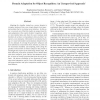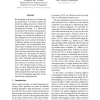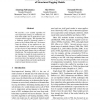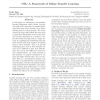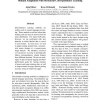117
Voted
ICCV
2011
IEEE
14 years 22 days ago
2011
IEEE
Adapting the classifier trained on a source domain to recognize instances from a new target domain is an important problem that is receiving recent attention. In this paper, we p...
96
Voted
ECIR
2011
Springer
14 years 4 months ago
2011
Springer
Adaptation techniques based on importance weighting were shown effective for RankSVM and RankNet, viz., each training instance is assigned a target weight denoting its importance ...
127
click to vote
AIPS
2011
14 years 4 months ago
2011
Applying learning techniques to acquire action models is an area of intense research interest. Most previous works in this area have assumed that there is a significant amount of...
115
Voted
ACL
2011
14 years 4 months ago
2011
It is well known that parsing accuracy suffers when a model is applied to out-of-domain data. It is also known that the most beneficial data to parse a given domain is data that ...
103
Voted
ACL
2011
14 years 4 months ago
2011
We consider a semi-supervised setting for domain adaptation where only unlabeled data is available for the target domain. One way to tackle this problem is to train a generative m...
138
click to vote
TNN
2011
14 years 7 months ago
2011
Domain adaptation solves a learning problem in a target domain by utilizing the training data in a different but related source domain. Intuitively, discovering a good feature rep...
115
Voted
EMNLP
2009
14 years 10 months ago
2009
Bootstrapping is the process of improving the performance of a trained classifier by iteratively adding data that is labeled by the classifier itself to the training set, and retr...
120
Voted
EMNLP
2010
14 years 10 months ago
2010
We describe a new scalable algorithm for semi-supervised training of conditional random fields (CRF) and its application to partof-speech (POS) tagging. The algorithm uses a simil...
96
Voted
ICML
2010
IEEE
15 years 1 months ago
2010
IEEE
In this paper, we investigate a new machine learning framework called Online Transfer Learning (OTL) that aims to transfer knowledge from some source domain to an online learning ...
100
Voted
EMNLP
2006
15 years 2 months ago
2006
Discriminative learning methods are widely used in natural language processing. These methods work best when their training and test data are drawn from the same distribution. For...
